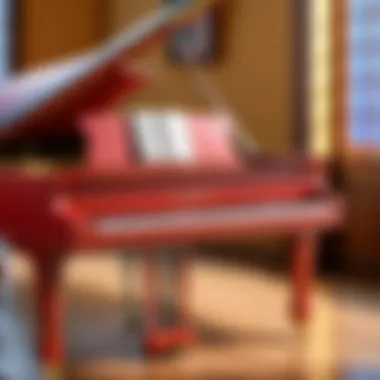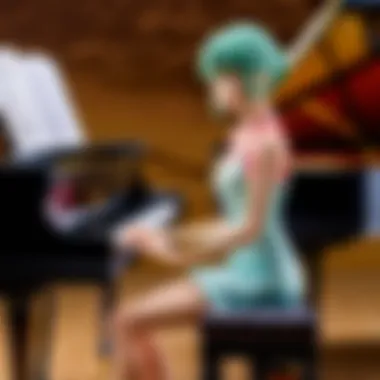Unlocking the Melodies: A Comprehensive Guide to Playing Anime Songs on Piano


Featured Figures and Merchandise
Are you an anime enthusiast and a piano player looking to elevate your music experience? Dive into the enchanting world of anime melodies with this comprehensive guide on playing anime songs on the piano. Before you embark on this musical journey, it's essential to understand the key elements that set anime music apart from other genres. Anime songs are known for their emotive melodies, diverse rhythms, and expressive harmonies, making them a delight for pianists to interpret and play. By unlocking the melodies of anime songs on the piano, you'll not only hone your musical skills but also immerse yourself in the captivating realm of anime soundtracks.
From iconic tracks like 'Unravel' from Tokyo Ghoul to the spirited openings of My Hero Academia, anime songs offer a rich tapestry of musical styles and emotions for you to explore. With each song brimming with its unique narrative and character, playing anime melodies on the piano becomes a profound way to connect with the stories and characters you love. Whether you're a seasoned pianist seeking new challenges or a beginner looking to infuse your practice with excitement, this guide will equip you with the knowledge and techniques needed to bring these captivating melodies to life on the piano.
Stay tuned as we delve deep into mastering anime songs on the piano, uncovering the secrets behind their enchanting compositions and offering practical tips to enhance your playing skills. Get ready to embark on a musical odyssey that will not only sharpen your piano prowess but also deepen your appreciation for the magical world of anime music.
Introduction
In the vast expanse of musical expression, anime songs on the piano hold a unique allure - a mystical bridge between art and emotion. The Introduction section of this guide serves as the cornerstone, laying the foundation for a harmonious journey through the enchanting realm of anime melodies on the piano. Here, aspiring pianists and anime aficionados converge to explore the intricate interplay of rhythm and harmonies that defines this musical genre.
Understanding the Appeal of Anime Music
Connection to Emotions
Delving into the nuanced tapestry of anime music reveals a profound connection to emotions that resonates deeply with listeners. The intertwining melodies evoke a kaleidoscope of feelings, from wistful nostalgia to exhilarating joy, crafting an emotional landscape that mirrors the diverse hues of human sentiment. This emotional resonance acts as a conduit, transcending cultural boundaries and speaking directly to the soul, making anime music a poignant and compelling choice for enthusiasts seeking to tap into the deeper realms of musical experience.
Cultural Significance
The cultural significance of anime music extends far beyond mere entertainment, weaving a rich tapestry of traditions, narratives, and histories into each melodious strand. Rooted in the vast legacy of Japanese artistic expression, anime music reflects a tapestry of cultural motifs, influences, and philosophies, offering a doorway into the vibrant universe of Japanese creativity. By immersing oneself in the cultural underpinnings of anime music, one not only discovers a trove of musical gems but also embarks on a transcultural odyssey that enriches the musical experience with layers of meaning and depth.
Diverse Genres
Within the expansive landscape of anime music lie a myriad of diverse genres, each offering a unique portal into musical exploration and discovery. From whimsical ballads to thunderous anthems, anime music traverses a kaleidoscope of genres, accommodating a vast array of tastes and preferences. This diversity not only caters to a wide audience but also presents endless opportunities for musical experimentation and creative expression. Embracing the diverse genres within anime music unlocks a treasure trove of musical possibilities, inviting enthusiasts to explore, adapt, and innovate within the multifaceted realm of anime melodies on the piano.
Getting Started with Piano
When embarking on the journey of playing anime songs on the piano, fundamental knowledge of piano basics is essential. Understanding the importance of Getting Started with Piano in this comprehensive guide is crucial as it sets the groundwork for mastering intricate anime melodies. The initial steps taken in learning the piano pave the way for enthusiasts to explore and enjoy the enchanting world of anime music fully. By delving into the basics of piano playing, individuals can grasp the necessary techniques and skills required to play anime songs with precision and emotion. Choosing the Right Instrument among digital and acoustic options is a significant decision that can greatly impact one's piano playing journey.
Choosing the Right Instrument
Digital vs. Acoustic
Delving into the realm of Digital vs. Acoustic pianos is vital in selecting the right instrument for playing anime songs. Digital pianos offer versatility and modern technology, making them a popular choice for enthusiasts diving into anime melodies. The key characteristic of Digital pianos lies in their ability to replicate a variety of sounds and provide features like headphone connectivity and recording capabilities, enhancing the practice experience. On the other hand, Acoustic pianos boast a classic touch and authentic sound that many pianists prefer for its traditional appeal. Their unique feature lies in the natural resonance and tactile response of the keys, providing a rich playing experience. Understanding the advantages and disadvantages of Digital vs. Acoustic pianos is crucial in determining which instrument aligns best with the player's preferences and goals.


Keyboard Features
Discussing Keyboard Features sheds light on the intricacies that contribute to the overall piano playing experience. The key characteristic of Keyboard Features is their impact on sound quality, responsiveness, and playability, all crucial elements when striving to master anime melodies. Each keyboard feature, such as weighted keys, touch sensitivity, and polyphony, plays a significant role in how the instrument responds to the player's touch and technique. Understanding these unique features not only enhances the playing experience but also influences the nuances and expression conveyed while performing anime songs. Exploring the advantages and disadvantages of various Keyboard Features helps enthusiasts make informed decisions when selecting an instrument suitable for unlocking the melodies of anime songs on the piano.
Basic Piano Techniques
To embark on the harmonic journey of playing anime songs on the piano, mastering basic piano techniques lays a solid foundation. These fundamental skills are crucial for aspiring pianists, facilitating the progression towards complex melodies with finesse. Understanding basic piano techniques encompasses various elements essential to hone one's musical prowess. From proper hand placement to efficient posture, each aspect contributes significantly to the player's ability to execute melodies accurately and expressively. By delving into basic piano techniques, enthusiasts can refine their playing style, enhance their technical abilities, and navigate the intricate world of anime music with confidence and skill.
Posture and Hand Placement
Proper Sitting Position
Considering the paramount importance of maintaining proper posture while playing the piano, the concept of a proper sitting position holds significant weight in this musical pursuit. The alignment of the spine, the positioning of feet on the pedals, and the distance from the piano all play a crucial role in achieving optimal playing conditions. Embracing a proper sitting position not only ensures comfort during extended playing sessions but also minimizes the risk of muscular strain and injuries inherent to improper postures. This ergonomic approach to piano playing promotes longevity and efficiency in practice, enabling players to channel their focus entirely on mastering intricate anime melodies.
Hand Positioning
An equally vital aspect of basic piano techniques, hand positioning influences the execution of notes, dynamics, and articulation in playing anime songs on the piano. Correct hand positioning involves maintaining a relaxed yet agile posture, with fingers poised to navigate the keyboard effortlessly. The curvature of the fingers, the positioning of the wrists, and the distribution of weight across the hands all contribute to achieving a melodious flow and precision in musical performance. By mastering optimal hand positioning, pianists can unlock the full potential of their musical expression, delivering nuanced interpretations of anime tunes with grace and fluidity.
Understanding Musical Notes
In the realm of playing anime songs on the piano, a fundamental aspect to grasp is Understanding Musical Notes. This knowledge serves as the bedrock for interpreting and performing intricate melodies with precision. By comprehending musical notes, enthusiasts can decipher the compositional nuances embedded within each anime song, allowing for a more authentic and emotive rendition. Understanding how notes correspond to sounds is crucial for capturing the essence of anime music and translating it into captivating piano performances. Furthermore, delving into the intricacies of musical notes enhances one's ability to explore the depth and complexity of different compositions.
Note Reading
Treble Clef vs. Bass Clef
When immersing oneself in the world of musical notation, the differentiation between Treble Clef and Bass Clef emerges as a pivotal component. The Treble Clef, also known as the G Clef, symbolizes higher-pitched notes typically played with the right hand on the piano. In contrast, the Bass Clef, or F Clef, signifies lower-pitched notes traditionally played with the left hand. This distinction aids pianists in understanding the range and positioning of notes on the musical staff, facilitating a seamless execution of anime melodies that span various octaves. Embracing the nuances of both Treble Clef and Bass Clef equips individuals with a comprehensive foundation for tackling a wide array of anime compositions.
Identifying Notes
In the context of playing anime songs on the piano, the skill of Identifying Notes holds immense significance. This proficiency enables pianists to recognize and interpret individual notes within a musical piece accurately. By honing the ability to identify notes swiftly and accurately, players can navigate through complex melodies with fluency and precision. Moreover, mastering the art of note identification empowers individuals to deconstruct intricate anime tunes into manageable segments, fostering a systematic approach to learning and mastering each composition. Through consistent practice and refinement of note recognition skills, piano enthusiasts can elevate their playing capabilities and embark on a fulfilling musical journey enriched with vibrant anime melodies.
Playing Anime Songs
Playing anime songs on the piano is a pivotal aspect of this comprehensive guide aimed at enthusiasts seeking to explore the captivating world of anime music. Anime songs, deeply rooted in storytelling and emotion, offer a unique opportunity for pianists to immerse themselves in diverse melodies that resonate with the heart and soul. By delving into playing anime songs, musicians can enhance their musical repertoire, hone their skills in interpretation, and connect with a global community of anime music aficionados.
Selecting Suitable Songs


Popular Anime Titles
Exploring popular anime titles is essential in this guide as it allows pianists to discover well-known and beloved melodies that carry significant emotional and nostalgic value. These popular anime songs often have a wide appeal, making them ideal for pianists of varying skill levels to tackle. By selecting popular anime titles, pianists can tap into the shared cultural experience associated with these iconic tunes, further enriching their musical journey.
Difficulty Levels
Understanding the varying difficulty levels of anime songs is crucial for pianists aiming to challenge themselves and grow as musicians. Different songs offer diverse technical challenges and musical complexities, catering to pianists at different stages of their playing journey. By exploring songs across different difficulty levels, musicians can expand their playing capabilities, build resilience through overcoming challenges, and experience a sense of achievement as they master more intricate pieces.
Breaking Down Melodies
Segmenting Songs
Breaking down melodies into segments is a powerful technique that aids pianists in digesting complex musical arrangements more effectively. By segmenting songs, musicians can focus on mastering smaller sections before tackling the piece as a whole, enhancing precision and overall performance quality. This systematic approach also promotes a deeper understanding of the music, allowing pianists to dissect intricate melodies and uncover hidden nuances within the composition.
Mastering Sections
Mastering sections of a song is a cornerstone of honing piano playing skills, enabling musicians to perfect challenging passages and elevate their overall performance. By dedicating focused practice to mastering different sections of a melody, pianists can cultivate technical proficiency, refine their expressive interpretation, and achieve greater fluency in playing complex musical arrangements. This deliberate approach to mastering sections fosters incremental progress and empowers pianists to tackle even the most demanding pieces with confidence.
Adding Personal Flair
Interpretation
Infusing personal interpretation into music is a distinctive aspect of piano playing that allows musicians to express their individuality and emotion through their performance. Interpretation adds depth and character to a piece, showcasing the pianist's unique perspective and artistic sensibility. By honing their interpretative skills, musicians can imbue anime songs with personal flair, creating memorable and deeply resonant performances that captivate audiences and evoke powerful emotions.
Improvisation
Embracing improvisation in piano playing opens up new avenues for creative expression and spontaneity, fostering innovation and musical exploration. Improvisation empowers pianists to unleash their creativity, experiment with different musical ideas, and imbue their performances with a sense of freshness and originality. By incorporating improvisational elements into anime songs, musicians can breathe new life into familiar melodies, adding a dynamic and improvisational touch that sets their performances apart.
Practicing Efficiently
In navigating the terrain of playing anime songs on the piano, the pivotal aspect of practicing efficiently emerges as a cornerstone for progression and mastery. Efficient practice not only refines technical skills but also cultivates a deep understanding of musical nuances present in anime melodies. By dedicating focused effort to practice sessions, enthusiasts can elevate their proficiency and unlock the true essence of each composition. The significance of practicing efficiently lies in its ability to hone precision, enhance musical interpretation, and instill a sense of discipline essential for musical growth. Through systematic and deliberate practice routines, pianists can sharpen their playing techniques, thereby embarking on a journey towards musical fluency and artistic expression.
Consistent Practice
Establishing a Routine


Delving into the realm of establishing a practice routine unveils an essential component for sustained progress and skill development in piano performance. The core essence of establishing a routine lies in its capacity to establish consistency and structure in one's practice regimen. Setting aside dedicated time slots for daily practice not only boosts productivity but also nurtures a sense of accountability towards personal growth and improvement. A well-thought-out practice routine aids in optimizing practice sessions, ensuring a balanced focus on technique, musical expression, and repertoire mastery. This meticulous approach not only fosters a disciplined practice habit but also fosters a conducive environment for gradual skill enhancement and profound musical insights.
Setting Goals
Delving into the realm of goal setting illuminates a strategic element crucial for aligning aspirations with tangible outcomes in piano performance. Setting specific, measurable, achievable, relevant, and time-bound (SMART) goals provides a roadmap for gauging progress and charting a clear path towards musical excellence. The intrinsic value of setting goals lies in fostering commitment, motivation, and a sense of purpose in one's musical journey. By delineating short-term and long-term objectives, pianists can track their growth, celebrate achievements, and identify areas for improvement effectively. Moreover, setting well-defined goals nurtures a sense of direction, instilling a drive for continual self-improvement and artistic advancement in the pursuit of playing anime songs with proficiency and finesse.
Seeking Additional Resources
In the realm of mastering anime songs on the piano, seeking additional resources plays a pivotal role in enhancing one's skills and depth of knowledge. This section sheds light on the significance of exploring supplementary avenues to refine piano playing abilities, offering enthusiasts a well-rounded approach to their musical journey. By diving into online tutorials and courses, learners can access a wealth of information and guidance tailored to their specific needs, ultimately propelling their musical pursuits.
Online Tutorials and Courses
Online tutorials and courses serve as a valuable asset to individuals looking to immerse themselves in the realm of anime music on the piano. These digital resources provide flexibility and convenience, allowing learners to hone their skills at their own pace and within the comforts of their own space. Virtual lessons, as a subset of online resources, offer a personalized learning experience that caters to individual styles and preferences. Their interactive nature fosters engagement and encourages mastery of intricate anime melodies, making them an indispensable tool in the pursuit of piano proficiency.
Virtual Lessons
Virtual lessons stand out for their interactive features that simulate in-person instruction, bridging the gap between traditional and modern learning methods. This dynamic approach enables learners to receive real-time feedback, correct mistakes instantly, and engage in immersive practice sessions. The personalized feedback offered in virtual lessons enhances the learning process, allowing students to focus on specific areas of improvement and track their progress systematically. While the convenience of virtual lessons is undeniable, learners must also stay self-disciplined to maximize the benefits of this mode of instruction.
Educational Platforms
Educational platforms serve as comprehensive hubs of knowledge and skill development, offering a diverse range of courses and resources for piano enthusiasts. These platforms curate content from experts in the field, providing learners with access to high-quality instructional materials and curated curricula. The structured nature of educational platforms streamlines the learning process, allowing individuals to progress systematically through modules and lessons. However, while educational platforms offer convenience and a structured learning path, learners should actively seek supplemental practice to fine-tune their skills and ensure a well-rounded musical education.
Refining Your Skills
Joining Piano Communities
Online Forums
Local Clubs
Conclusion
In the realm of playing anime songs on the piano, the conclusion serves as the culmination of the musical journey embarked upon by enthusiasts. It encapsulates the essence of dedication, practice, and emotion that define the process of mastering intricate anime melodies. The conclusion is not merely a conclusion but a gateway to further exploration and refinement of skills in the musical sphere. It signifies the achievement of milestones, both big and small, along the path of musical growth and evolution. Embracing the concluding phase of learning anime songs on the piano is akin to acknowledging one's progress while anticipating new horizons to conquer, making it an essential component in the holistic development of piano playing skills.
Embracing the Journey
Continuous Improvement
Delving into the realm of continuous improvement in piano playing unveils a pivotal aspect of skill enhancement—an iterative process of refining techniques, interpreting melodies, and honing musical expressions. The beauty of continuous improvement lies in its adaptability and flexibility, allowing individuals to incorporate feedback, learn from mistakes, and progress steadily towards mastery. Its key characteristic of iterative refinement enables players to fine-tune their skills incrementally, ensuring a gradual yet significant enhancement in their musical abilities. Continuous improvement is a preferred choice within this article due to its sustainable nature, fostering consistent progress and fostering a mindset of growth and development among aspiring pianists. Its unique feature lies in the personalized growth trajectory it offers, tailored to individual learning paces and preferences. While continuous improvement demands dedication and perseverance, its advantages in this article are manifold, contributing to a steady advancement in piano proficiency and musical comprehension.
Enjoying the Process
Navigating through the landscape of piano playing, 'enjoying the process' emerges as a fundamental element that fuels passion, sustains motivation, and redefines the journey of learning anime songs. Its key characteristic of infusing joy and enthusiasm into each practice session transforms the act of playing the piano from a mere technical exercise to a fulfilling and immersive experience. 'Enjoying the process' is a favored choice in this article due to its ability to nurture a harmonious connection between player and music, fostering creativity, emotional expression, and musical exploration. Its unique feature lies in its capacity to cultivate a sense of fulfillment and satisfaction, enriching the learning process and instilling a deep appreciation for the art of piano playing. While 'enjoying the process' requires patience and a mindful approach, its advantages in this article are abundant, fostering a sustainable and meaningful musical journey filled with joy, inspiration, and personal growth.



